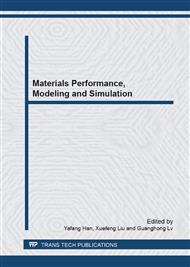[1]
P.R. Subramanian, M.G. Mendiratta, D.M. Dimiduk, Advanced intermetallic alloys beyond gamma titanium aluminides, Mater. Sci. Eng., A. 239-240 (1997) 1-13.
DOI: 10.1016/s0921-5093(97)00555-8
Google Scholar
[2]
M.G. Mendiratta, J.J. Lewandowski, D.M. Dimiduk, Strength and ductile-phase toughening in the two-phase Nb/Nb5Si3 alloys, Metall. Mater. Trans. A. 22 (1991) 1573-1583.
DOI: 10.1007/bf02667370
Google Scholar
[3]
L.N. Jia, X.P. Guo, Effects of Alloying Elements and Heat Treatments on the Microstructure and Mechanical Properties of Refractory Metal Silicide-Based Alloys, RARE METAL MAT ENG. 36 (2007) 1304-1308.
Google Scholar
[4]
S.K. Varma, C. Parga, K. Amato, J. Hernandez, Microstructures and high temperature oxidation resistance of alloys from Nb–Cr–Si system, J. Mater. Sci. 45 (2010) 3931-3937.
DOI: 10.1007/s10853-010-4458-8
Google Scholar
[5]
J.K. Zhai, Metal High-temperature Corrosion, Beihang University Press, Beijing, 1994, p.4.
Google Scholar
[6]
G. Shao, Thermodynamic modelling of the Cr–Nb–Si system, Intermetallics. 13 (2005) 69-78.
DOI: 10.1016/j.intermet.2004.06.003
Google Scholar
[7]
R. Tewari, H. Song, A. Chatterjee, V.K. Vasudevan, Microstructural characterization of multicomponent Nb-Ti-Si-Cr-Al-X alloys, Metall. Mater. Trans. A. 37 (2006) 2669-2682.
DOI: 10.1007/bf02586101
Google Scholar
[8]
J. Geng, P. Tsakiropoulos, G.S. Shao, Oxidation of Nb–Si–Cr–Al in situ composites with Mo, Ti and Hf additions, Mater. Sci. Eng., A. 441 (2006) 26-38.
DOI: 10.1016/j.msea.2006.08.093
Google Scholar
[9]
J.C. Zhao, M.R. Jackson, L.A. Peluso, Evaluation of phase relations in the Nb-Cr-Al system at 1000°C using a diffusion-multiple approach, JPEDAV. 25(2004) 152-159.
DOI: 10.1361/15477030418550
Google Scholar
[10]
B.P. Bewlay, Y. Yang, R.L. Casey, M.R. Jackson, Y.A. Chang, Experimental study of the liquid–solid phase equilibria at the metal-rich region of the Nb–Cr–Si system, Intermetallics. 17 (2009) 120-127.
DOI: 10.1016/j.intermet.2008.10.005
Google Scholar
[11]
A. Deal, W. Heward, D. Ellis, J. Cournoyer, K. Dovidenko, B.P. Bewlay. Phase Identification in Nb-Cr-Si Alloys, Microsc. Microanal. 13 (2007) 90-91.
DOI: 10.1017/s1431927607079275
Google Scholar
[12]
G. Kresse, J. Furthmüller, Efficient iterative schemes for ab initio total-energy calculations using a plane-wave basis set, Phys. Rev. B. 54 (1996) 11169-11186.
DOI: 10.1103/physrevb.54.11169
Google Scholar
[13]
G. Kresse, J. Furthmüller, Efficiency of ab-initio total energy calculations for metals and semiconductors using a plane-wave basis set, Comput. Mater. Sci. 6 (1996) 15-50.
DOI: 10.1016/0927-0256(96)00008-0
Google Scholar
[14]
D. Vanderbilt, Soft self-consistent pseudo potentials in a generalized eigenvalue formalism, Phys. Rev. B. 41 (1990) 7892-7895.
DOI: 10.1103/physrevb.41.7892
Google Scholar
[15]
J.P. Perdew, K. Burke, Ernzerhof M. Generalized Gradient Approximation Made Simple, Phys. Rev. Lett. 77 (1996) 3865-3868.
DOI: 10.1103/physrevlett.77.3865
Google Scholar
[16]
M.A. Blanco, E. Francisco, V. Luaña, GIBBS: isothermal-isobaric thermodynamics of solids from energy curves using a quasi-harmonic Debye model, Comput. Phys. Commun. 158 (2004) 57-72.
DOI: 10.1016/j.comphy.2003.12.001
Google Scholar
[17]
E. Francisco, M.A. Blanco, G. Sanjurjo, Atomistic simulation of SrF2 polymorphs, Phys. Rev. B. 63 (2001) 094107.
Google Scholar
[18]
E. Francisco, J.M. Recio, M.A. Blanco, A.M. Pendás, Quantum-Mechanical Study of Thermodynamic and Bonding Properties of MgF2, J. Phys. Chem. A. 102 (1998) 1595-1601.
DOI: 10.1021/jp972516j
Google Scholar
[19]
R. Liu, J.X. Shang, First-principles study of thermal properties and phase transition between β -Ti3O5and λ-Ti3O5, Modell. Simul. Mater. Sci. Eng. 20 (2012) 035020.
Google Scholar
[20]
R. Liu, J.X. Shang, Firdt Principle Stuy on C, N Doped Ti3O5, Journal of Synthetic Crystals. 41 (2012) 376-380.
Google Scholar
[21]
K.D. Maglić, N.L. Perović, G.S. Vuković, L.P. Zeković, Specific heat and electrical resistivity of niobium measured by subsecond calorimetric technique, Int. J. Thermophys. 15 (1994) 963-972.
DOI: 10.1007/bf01447106
Google Scholar
[22]
A. Kellou, T. Grosdidier, C. Coddet, H. Aourag, Theoretical study of structural, electronic, and thermal properties of Cr2(Zr, Nb) Laves alloys, Acta Mater. 53 (2005) 1459-1466.
DOI: 10.1016/j.actamat.2004.11.039
Google Scholar
[23]
Y. Chen, T. Hammerschmidt, D.G. Pettifor, J.X. Shang, Y. Zhang, Influence of vibrational entropy on structural stability of Nb–Si and Mo–Si systems at elevated temperatures, Acta Mater. 57 (2009) 2657-2664.
DOI: 10.1016/j.actamat.2009.02.014
Google Scholar
[24]
S. Hong, C.L. Fu, Theoretical study on cracking behavior in two-phase alloys Cr–Cr2X (X=Hf, Nb, Ta, Zr), Intermetallics. 9 (2001) 799-805.
DOI: 10.1016/s0966-9795(01)00069-3
Google Scholar
[25]
Y. Chen, J.X. Shang, Y. Zhang, Effects of alloying element Ti on α-Nb5Si3 and Nb3Al from first principles, J. Phys.: Condens. Matter. 19(2007) 016215.
DOI: 10.1088/0953-8984/19/1/016215
Google Scholar
[26]
Fran Cverna, ASM Ready Reference: Thermal Properties of Metals, ASM International, Ohio, 2002, pp.9-10.
Google Scholar
[27]
F.Z. Lian, Materials Physical Properties, Northeast University Press, Shenyang, 2005, p.175.
Google Scholar
[28]
L.C. Xing. Tantalum and Niobium metallurgy, Metallurgical Industry Press, Beijing, 1982, p.1.
Google Scholar
[29]
L.T. Zhang, J.S. Wu, Thermal expansion and elastic moduli of the silicide based intermetallic alloys Ti5Si3(X) and Nb5Si3, Scripta Mater. 38 (1998) 307-313.
DOI: 10.1016/s1359-6462(97)00496-x
Google Scholar
[30]
S. Hong, C.L. Fu, Phase stability and elastic moduli of Cr2Nb by first-principles calculations, Intermetallics. 7 (1999) 5-9.
DOI: 10.1016/s0966-9795(98)00005-3
Google Scholar
[31]
S. Lee, P.K. Liaw, C.T. Liu, Y.T. Chou, Cracking in Cr–Cr2Nb eutectic alloys due to thermal stresses, Mater. Sci. Eng., A. 268 (1999) 184-192.
DOI: 10.1016/s0921-5093(99)00068-4
Google Scholar


